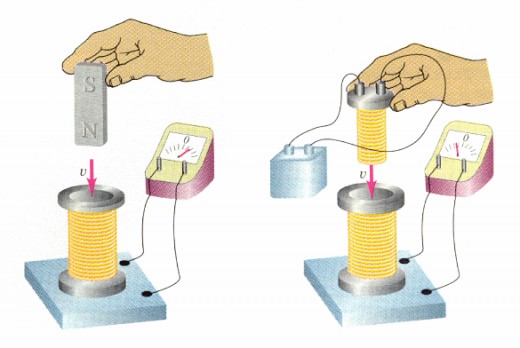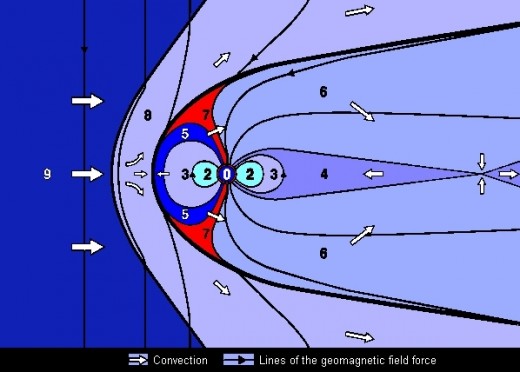Harvesting Power from Induction
Faraday discovered the principle of induction and we have run with it ever since.

Obtaining wireless electrical power is rather simple all things considered
Everyone is interested in getting free energy. There exists a way of capturing energy that is already being transmitted along high tension power lines. Now the legality of doing this is admittedly in the grey area, as power companies would frown on anyone tapping into their power grid even though there is no direct physical connection other than via the electromagnetic field and the physics of resonance. In each case, it is a matter of property definitions and who ultimately pays for the use of electrical power.
Other than this consideration, electrical energy along a conductor creates a magnetic field around the wires themselves that are perpendicular to the direction of the current flow; usually along the length of the wires overhead. Typically, AC current “vibrates” at a frequency of 60 Hertz, (50 in Europe). It makes 30 of these complete cycles for an AC current every second. This creates a 30 cycles per second (CPS) sine wave function in the wires that build to a maximum, collapse to zero and rebuild twice in 1/30th of a second for one complete cycle. The magnetic field follows the electrical cycle in perfect sync and propagates at the velocity of light. It is this changing magnetic field that can be tapped. Just as electrical forces can generate magnetism, the reverse is also true. The key in each case, is a changing intensity.
As the magnetic cycle is operating in synch with the pulses of AC electrical energy on the high tension lines, the field propagates through space and falls off by the inverse of the square to the distance from the source. Thus, a field strength at the source; the electrical current carrying lines of 500,000 volts will drop to a mere few volts of potential near the ground. It is thus the height of the line towers that prevents arcing to the ground unless the air is heavily polluted. But the fact that the available current is only a puny few volts should not prevent the collection and amplification of power. Every single electrical transformer works by induction and these can be made to increase or decrease the electrical power from the input circuit to the output circuit. This also applies to the air transformer, such as a Tesla coil.
The idea is simplicity at its best. You will need several pieces of heavy and conductive cable that will be laid parallel to the lines overhead. These will be connected in series and parallel in order to capture the two facets of electrical energy; that is, the voltage, done in series and the current (amperage) done in parallel. The series section is simple and it is done by taking a single conductor of sufficient length and making wide loops with part of the loop under the overhead wires. The parallel section is done with several short and separate pieces laid in parallel and connected to a single conductor, one for each end. There will be some experimental tweaking to get the correct voltage and current for something like a power saw, typically rated at 120 volts and 10 to 14 amps. Done right, you should be able to run equipment directly off your loops. If you are going to run more than one piece of equipment at a time, then you will have to upgrade accordingly at the source of your power.
Obtaining power in this fashion is something that Tesla was able to accomplish and incidentally, he is the father of Alternating Current (AC). This is one of the foundation principles of wireless power transmission that Tesla developed and he was working in the millions of volts. Tesla also recognized the importance of resonance, so he would tune his coils to get the maximum efficiency out of them. As part of the induction system incorporates coils, you will be required to do some tuning to get the correct level of output. A multimeter is therefore an essential piece of measuring equipment to determine the output of your system plus or minus 5 percent, which is considered within the acceptable range of error.
The method of gaining power from induction is a bare bones description that you will need to tweak and achieve the right output for your needs in the available electrical environment. As long as power flows through the power lines, you will not need back up batteries. If you do decide to incorporate a back up system, then you will need a rectifier in order to screen out half of the AC power to create DC electrical power for battery charging.
Why would you need induction power. Well that is a question that each of us may have to answer on our own. One particular use comes to mind. If your vehicle breaks down and you need power to run tools for repair, there is usually overhead power lines that can be tapped. These run alongside most highways, but are often a lot less powerful than the high tension lines. It's nice to know that you aren't totally helpless stuck in the middle of nowhere. This is just one idea.
References
http://en.wikipedia.org/wiki/Electromagnetic_induction
http://www.ndt-ed.org/EducationResources/CommunityCollege/EddyCurrents/Physics/inductance.htm
The earth's magneric field can be tapped to generate electricity

Tapping the Geomagnetosphere for Electrical Power
While exploring the the interrelation of electricity and magnetism and becoming familiar with inductance, there is a little known way to obtain electrical power for free. As you should know by now, electrical current and magnetic fields are interactive. The only requirement to establish a flow of electricity through a circuit is to have a source of it, whether a battery or a changing magnetic field. Now the earth has a magnetic field and even though we cannot change it, there is something else that we can; and that is part of the circuit itself that we will use to induce current from the geomagnetosphere.
By taking a loop of wire that consists of a minimum of several windings in the loop and a multimeter attached at both ends, we can quickly establish that electrical energy can be created by holding the loop and wiggling it back and forth. This is a simplified generator and with enough windings in the loop, you can generate a sizable current. The multimeter will allow us to determine how much voltage and current we can get in an experiment and give us a baseline where we can calculate what changes we need to make to get the desired amount of free electrical energy.
Taking it to the next step, we can incorporate the loops into a horizontally or angle mounted windmill and get the wind to spin the loops through the geomagentosheric lines of magnetic force. The design in amazingly simple to the point that a young child should be able to make a working wind electrical generator with no magnets except for the magnetism the earth itself provides. Even tough there is talk of the collapse of the earth's magnetic field, the fact is that it is going through a reversal and a peropd of chaos. There is always some magnetic energy, even during the chaotic period.








